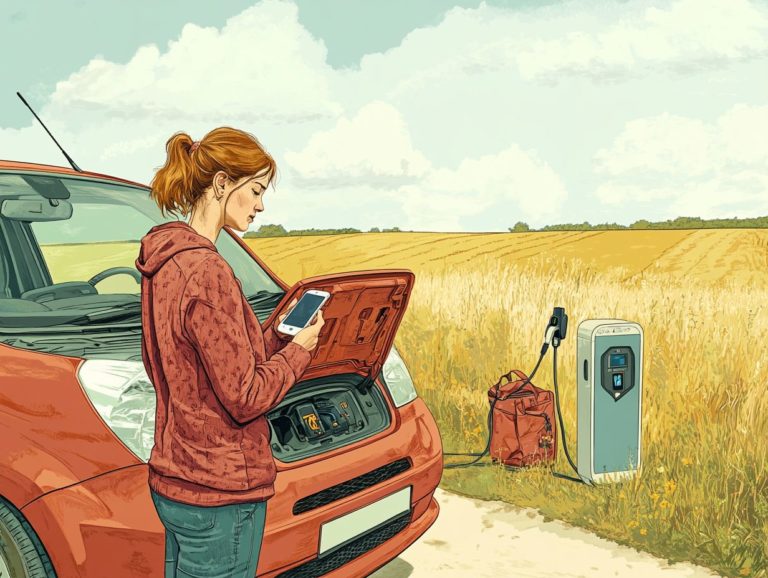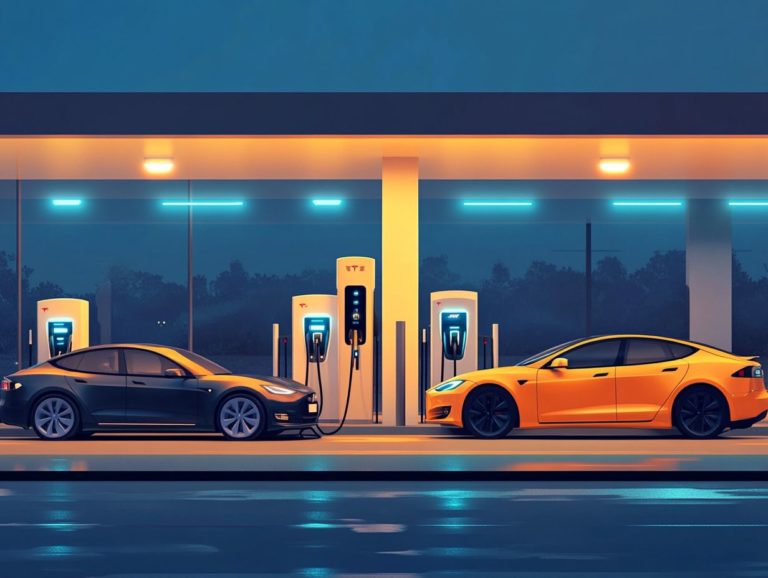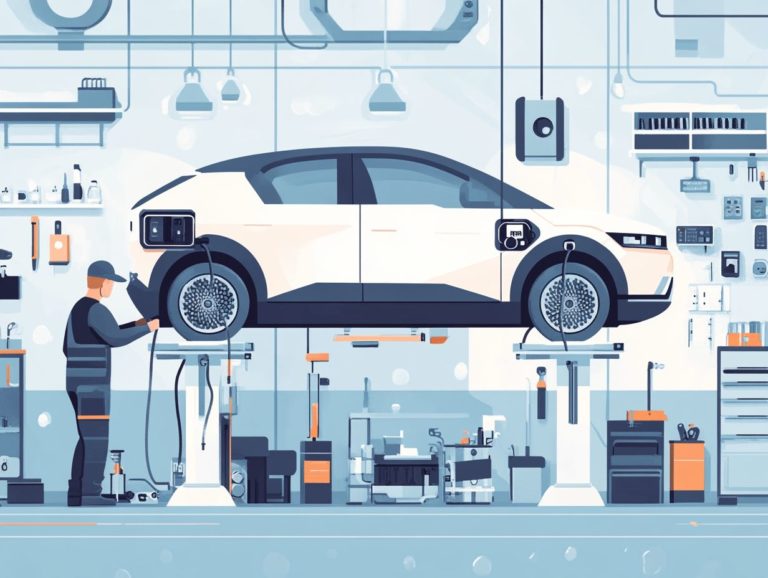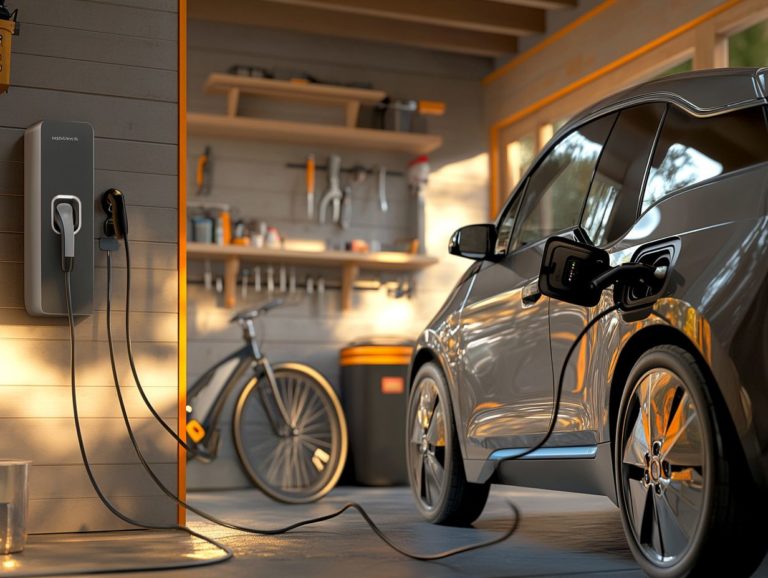How Do Electric Vehicles Perform in Cold Weather?
As winter draws near, you might wonder how your electric vehicle (EV) will perform in colder temperatures. Cold weather can significantly impact battery efficiency and driving range.
However, you can use effective strategies and best practices to help you gracefully navigate the winter months with your EV. This article delves into the effects of cold weather on electric vehicles, offering valuable insights on how to prepare for winter driving, optimize your vehicle’s performance, and keep it in peak condition despite the frosty conditions.
Contents
- Key Takeaways:
- The Impact of Cold Weather on Electric Vehicles
- Strategies for Improving Electric Vehicle Performance in Cold Weather
- Charging Considerations in Cold Weather
- Winter Maintenance Tips for Electric Vehicles
- Frequently Asked Questions
- How do electric vehicles perform in cold weather?
- Do electric vehicles have trouble starting in cold weather?
- Can I use a block heater for an electric vehicle in cold weather?
- Does the heating system in an electric vehicle drain the battery in cold weather?
- Do electric vehicles perform better in cold weather than gasoline vehicles?
- How can I improve my electric vehicle’s performance in cold weather?
Key Takeaways:

- Electric vehicles can experience reduced range in cold weather due to low temperatures affecting battery efficiency.
- Pre-trip preparations and modifying driving techniques can enhance performance in cold conditions.
- When charging an electric vehicle in cold weather, it’s important to consider how low temperatures can affect charging time and follow best practices for safe and efficient charging.
The Impact of Cold Weather on Electric Vehicles
Cold weather exerts a notable influence on electric vehicles (EVs), affecting their battery performance, driving range, and energy consumption, as detailed in how weather affects your EV’s performance.
As temperatures dip, the chemistry of lithium batteries can shift, leading to diminished performance and affecting your driving experience in electric cars.
In regions like Chicago, where winter can be particularly harsh, it’s essential for Tesla owners and other EV enthusiasts to grasp how frigid climates influence battery temperature and overall functionality. Being informed about these effects can help you navigate the winter months with greater confidence and ensure optimal performance from your electric vehicle.
How Temperature Affects Battery Performance
Temperature significantly influences battery performance, especially regarding lithium batteries in electric vehicles. As temperatures dip, the chemistry of the battery can shift, leading to a decline in charge capacity.
This can increase the risk of lithium plating, where lithium metal forms on the battery s surface, reducing its effectiveness. Research shows that when the temperature falls below 32 F (0 C), lithium-ion batteries can experience a capacity reduction of up to 20-30%.
This substantial decrease highlights the importance of having effective battery management systems. These systems help keep track of battery temperatures and charging, ensuring your EV runs smoothly.
Preconditioning your batteries before driving in extremely low temperatures can be a game changer for maintaining efficiency. By warming up the battery before use, electric vehicle owners can ensure better range and reliability, making those winter drives smoother and safer.
Other Factors that Contribute to Cold Weather Performance
Several factors shape the overall performance of electric vehicles in cold climates, influencing not just your driving range but also charging performance and energy efficiency.
The heating system is crucial for maintaining battery temperature, as electric vehicles often depend on heating energy to keep the cabin comfortable during brutal winter months.
When temperatures drop, the chemistry of the battery shifts, resulting in decreased efficiency and performance. This cold-induced sluggishness can lead to increased energy consumption.
If you’re operating commercial EVs in colder regions, you face even more challenges. Prolonged heat demand can significantly cut into your available driving range, complicating route planning and logistics.
Implementing strategies such as preconditioning the batteries and optimizing heating functions can help mitigate some of these issues. This way, your fleet operations remain effective even when the temperature plummets.
Strategies for Improving Electric Vehicle Performance in Cold Weather
To optimize the performance of electric vehicles in cold weather, you can employ several effective strategies. Utilizing advanced EV chargers and preconditioning the battery before your trips are key moves.
These tips will supercharge your driving experience and overall battery management in colder climates, ensuring that your electric car operates at its peak even in extreme conditions.
Pre-Trip Preparations

Pre-trip preparations are crucial for ensuring your electric vehicle performs at its best in cold weather. A key focus should be on preconditioning the battery, which greatly enhances driving range and energy efficiency.
To maximize your vehicle s efficiency, consider using smartphone applications that provide real-time battery status updates. This way, you ll always know your charge levels before setting off on your journey.
By preconditioning the battery warming it up while plugged in you allow the vehicle to reach a more optimal thermal state. This results in improved performance when it s time to hit the road.
By following these proactive steps, especially in chilly climates, you can significantly mitigate the adverse effects of cold temperatures on battery health and efficiency. This not only gives you peace of mind but also ensures a smoother driving experience throughout your travels.
Driving Techniques
Adopting proper driving techniques in winter weather can significantly enhance energy efficiency and battery management for your electric vehicle, ensuring it remains reliable in cold climates.
By concentrating on maintaining a steady speed, you can minimize the energy fluctuations that often lead to battery drain. This approach conserves power and boosts overall vehicle performance, allowing for longer journeys between charges.
Utilizing regenerative braking a system that captures energy when slowing down becomes important in icy weather; it enables you to recover energy during deceleration, extending your battery life. These techniques ensure your vehicle remains dependable, giving you the power to navigate winter roads with confidence and maximize the potential of your electric vehicle in challenging weather.
Charging Considerations in Cold Weather
Charging electric vehicles in cold weather introduces distinct challenges that can impact both charging speed and overall efficiency. This situation requires careful consideration of factors such as NEMA ratings standards for electrical outlets and the availability of reliable charging stations.
Understanding how these factors connect can help you effectively navigate the complexities of charging your EV during the winter months.
How Cold Temperatures Affect Charging Time
Cold temperatures can have a significant impact on how long it takes to charge your electric vehicle, often prolonging the time it takes to reach a full battery. This happens because lower temperatures slow down the chemical reactions within the battery.
When the mercury drops, it’s not just your battery s efficiency that suffers; the whole charging system can face difficulties. This means longer wait times and more energy usage, so stay prepared!
To counter these effects, it s wise to keep an eye on local weather forecasts and consider preconditioning your vehicle while it’s still plugged in. By doing this, you can warm up the battery before starting the charging session, potentially minimizing the adverse effects of the cold on both charging time and energy needs.
Best Practices for Charging in Cold Weather
Implementing best practices for charging electric vehicles in cold weather is essential for optimizing energy efficiency and minimizing battery issues. This is especially important when using various types of charging stations.
To ensure smooth operation and extend the life of your vehicle’s battery, leverage NEMA-rated chargers. These chargers are specifically designed to withstand harsh temperatures, providing a reliable power source when it s most needed.
Keep your vehicle plugged in during extreme cold to alleviate battery drain, maintaining optimal charging conditions even when not in use.
Plan your charging sessions around your driving patterns to enhance efficiency. This way, you can take advantage of quicker top-ups during minimal usage times.
Embrace these strategies to conquer winter challenges and keep your vehicle thriving!
Winter Maintenance Tips for Electric Vehicles

Proper winter maintenance is crucial for your electric vehicle, especially if you live in a cold climate. To ensure optimal battery lifespan and performance, be proactive.
Harsh conditions can lead to performance drops and an uptick in battery-related issues. Taking the time to care for your vehicle in winter months is well worth the effort.
- Check battery health regularly.
- Keep tires properly inflated.
- Park in a garage when possible.
Protecting the Battery and Other Components
Protecting the battery and other components of electric vehicles during winter months is essential for preventing performance declines. This ensures reliable operation in extreme temperatures.
To achieve this, an effective temperature control system is crucial. It helps keep the battery at the right temperature, preventing overheating or extreme cooling that could affect performance. Ensure that the heating system operates at peak efficiency to maintain the battery s ideal temperature range, which is vital for enhancing longevity.
By proactively managing these aspects, you can significantly improve the durability and efficiency of your electric vehicle components, leading to a superior driving experience even in harsh winter conditions.
Preparing for Winter Driving
Preparing for winter driving in electric vehicles requires a nuanced understanding of cold weather impacts on battery management, alongside strategic route planning to optimize driving range and energy consumption.
As temperatures dip, you may notice a decline in battery performance, leading to a reduction in range. Charge your EV fully before heading out don’t let the cold catch you off guard!
Identifying charging stations along your planned route is a prudent move, as access can be limited in certain areas during colder months. By pre-conditioning your vehicle while it’s still plugged in, you can help safeguard your battery’s longevity.
Incorporating eco-driving techniques, like smooth acceleration and regenerative braking, will further enhance your efficiency on slick, icy roads.
Frequently Asked Questions
How do electric vehicles perform in cold weather?
Electric vehicles can perform well in cold weather, but expect some reduction in range. It may take longer to charge in the cold, so plan accordingly!
Do electric vehicles have trouble starting in cold weather?

No, electric vehicles do not have the same starting issues as traditional gasoline vehicles in cold weather. They rely on an electric motor, eliminating the need for a combustion engine and the associated starting process.
Can I use a block heater for an electric vehicle in cold weather?
It is not necessary to use a block heater for an electric vehicle in cold weather. The battery and electric motor can still function in cold temperatures without additional heating.
Does the heating system in an electric vehicle drain the battery in cold weather?
Yes, the heating system can drain the battery faster when it’s cold. Use seat heaters to save battery life instead of cranking up the heat.
Do electric vehicles perform better in cold weather than gasoline vehicles?
It varies by model and conditions. Generally, electric vehicles have advantages: they start easily and provide better traction on slippery roads.
How can I improve my electric vehicle’s performance in cold weather?
Warm up the inside using a smartphone app while it’s still plugged in. Also, keep your tires properly inflated for better traction.






